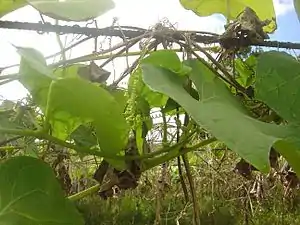Sechium
Sechium bilden eine Pflanzengattung innerhalb der Familie der Kürbisgewächse (Cucurbitaceae). Alle wilden Arten wachsen in Mexiko oder Zentralamerika. Es werden fleischige Früchte produziert; die Chayote (Sechium edule) wird in weiten Teilen der Subtropen bis Tropen kultiviert.
| Sechium | ||||||||||||
|---|---|---|---|---|---|---|---|---|---|---|---|---|

| ||||||||||||
| Systematik | ||||||||||||
| ||||||||||||
| Wissenschaftlicher Name | ||||||||||||
| Sechium | ||||||||||||
| P.Browne |
Beschreibung
_tacaco_-_Costa_Rica.jpg.webp)

Vegetative Merkmale
Es sind Laubblätter vorhanden.
Generative Merkmale
Es werden Früchte gebildet.
Systematik
Die Gattung Sechium wurde 1756 durch Patrick Browne in The Civil and Natural History of Jamaica in Three Parts, 355 aufgestellt.
Die Gattung Sechium gehört zur Untertribus Sicyinae aus der Tribus Sicyeae innerhalb der Familie der Cucurbitaceae. Der Umfang der Gattungen der Untertribus Sicyinae werden kontrovers diskutiert, dabei wurden auch alle Arten der Gattung Sechium in die Gattung Sicyos L., aber es wurde auch die Gattung Sechium reaktiviert.
Botanische Geschichte des letzten Jahrhunderts
Die Gattung Sechium umfasst etwa elf Arten, deren Einteilung kontrovers diskutiert wird. Studien der 90er Jahre teilen die Gattung übereinstimmend in zwei Sektionen Sechium und Frantzia ein. Die beiden Sektionen unterscheiden sich in der Morphologie der floralen Nektarien und der Anordnung der Staubblätter[1].
| Sektion Sechium | Sektion Frantzia (Pittier) C.Jeffrey |
|---|---|
|
|
Literatur
- Luis A. Barrera-Guzmán, Cadena-Iñiguez Jorge, Juan P. Legaria-Solano, Jaime Sahagún-Castellanos: Phylogenetics of the genus Sechium P. Brown: A review. In: Spanish Journal of Agricultural Research, Volume 19, Issue 1, Februar 2021, 07.
doi:10.5424/sjar/2021191-17036 Volltext-PDF.
- Luis Angel Barrera-Guzmán, Juan Porfirio Legaria-Solano, Jaime Sahagun-Castellano, Jorge Cadena-Iniguez: Phylogenetic relationships among Mexican species of the genus Sechium (Cucurbitaceae). In: Doga, Turkish Journal of Botany, Volume 45, Issue 4, Juli 2021, S. 302–314. doi:10.3906/bot-2007-18 Volltext-PDF.
- H. Schaefer, S. S. Renner: Phylogenetic relationships in the order Cucurbitales and a new classification of the gourd family (Cucurbitaceae). In: Taxon, Volume 60, Issue 1, 2011, S. 122–138. doi:10.1002/tax.601011
- C. Jeffrey, D. M. Bates, R. W. Robinson (eds.): Biology and Utilization of the Cucurbitaceae. Cornell University Press, Ithaca, 1990. (engl.)
Einzelnachweise
- Rafael Lira Saade, 1996: Chayote Sechium edule (Jacq.) Sw. Promoting the conservation and use of underutilized and neglected crops. 8. Institute of Plant Genetics and Crop Plant Research, Gatersleben/International Plant Genetic Resources Institute, Rom, ISBN 92-9043-298-5. Saade 1996 (Memento vom 25. Februar 2009 im Internet Archive) (PDF, 831 kB, engl.)